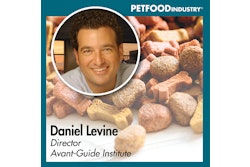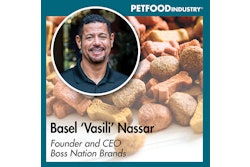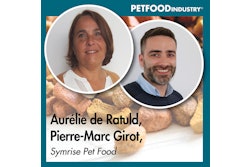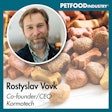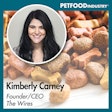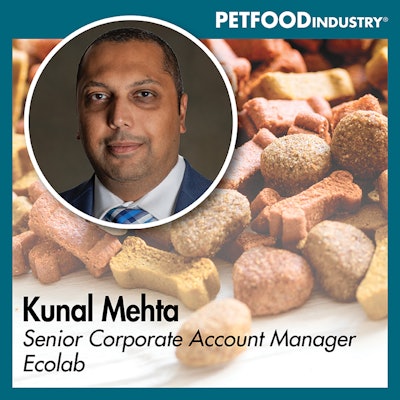
Senior Corporate Account Manager for Ecolab Kunal Mehta answers the question, "What role does water reduction play in sustainability when it comes to pet food processing?"
The below transcript is from Episode 58 of the Trending: Pet Food podcast, where host Lindsay Beaton spoke with Kunal Mehta, senior corporate account manager for Ecolab, about the various connections between what’s happening in the human food space and the trends driving the pet food space. You can find the episode at Trending: Pet Food Podcast, on SoundCloud or on your favorite podcast platform. This episode originally aired on March 26, 2024.
We want to thank AFB International for sponsoring this podcast. AFB is the premier supplier of palatants to pet food companies worldwide, offering off-the-shelf and custom solutions and services that make pet food, treats and supplements taste great.
Lindsay Beaton – Editor, Petfood Industry magazine and Host, Trending: Pet Food podcast: Hello, and welcome to Trending: Pet Food, the industry podcast where we cover all the latest hot topics and trends in pet food. I’m your host and editor of Petfood Industry magazine, Lindsay Beaton, and I’m here today with Kunal Mehta, senior corporate account manager at Nalco Water and Ecolab. Hi, Kunal, and welcome.
Kunal Mehta, senior corporate account manager at Nalco Water and Ecolab: Hi Lindsay. Thanks for having me.
Beaton: In case you’re not familiar with Kunal or Ecolab or Nalco Water, here’s what you need to know.
Kunal has over 20 years of experience with Nalco Water, supporting a variety of customer-facing roles across multiple industries, including pet food processing. In his current role, Kunal works with North American-based global customers to help them identify opportunities to reduce, reuse and recycle water so they can make progress on their sustainability and productivity goals.
A trusted partner for millions of customers, Ecolab is a global sustainability leader offering water, hygiene, and infection prevention solutions and services that protect people and the resources vital to life. Nalco Water, an Ecolab company, is Ecolab’s water and process management business.
Ecolab delivers comprehensive science-based solutions, data-driven insights and world-class service to advance food safety, maintain clean and safe environments, and optimize water and energy use for customers in the food, healthcare, life sciences, hospitality and industrial markets.
Kunal’s expertise in water conservation, and its timeliness as a topic in terms of sustainability, are why I’ve brought him on today to answer this question: What role does water reduction play in sustainability when it comes to pet food processing?
This is going to be a bit of a one-on-one setup, because most of the people listening to this podcast probably already know this answer, but just to lay some groundwork, what is the importance of water in the various aspects of pet food processing?
Mehta: Within pet food processing, water is used in every step of the process in different capacities. Water moved, cooled, it is heated and treated to be fit for use. As the pet food industry is growing. As you know, in 2017, the premium pet food sales were just shy of $35 billion. By 2027, it's expected to grow almost close to $60 billion. Why this is important is because the industry, especially the pet food processors are facing your pressures. They have to meet the growing demand with safety and quality at the forefront, but also addressing the complex sustainability landscape.
Beaton: You're right, it is a very complex landscape. It's interesting because I feel like for all that, water should be a go-to when it comes to sustainability, it's maybe gotten pushed out of the conversation a little bit by things like packaging or sustainable ingredients and things like that. What are you hearing from people in terms of wanting to deal with their water resources in a sustainable manner? Is it something people are coming to you with? Or is it more something you're reaching out to customers and saying, “Hey, have you even looked at your water usage as a method of sustainability?”
Mehta: It's definitely a mix, where many times customers are reaching out to us as a best practice as they are designing new equipment and new systems to proactively manage water. Also, there are times where we are supporting many customers in the pet food processing industry, our teams are on their processing plans and supporting these applications on a day-to-day basis where we help identify many ways to optimize water. Our goal is always to reduce, reuse and then find opportunities to recycle it.
Beaton: As you're working with people to use their water more sustainably in whatever ways they need to use them, what are some of the least efficient uses of water in the industry? What are some of the biggest changes that people are having to make?
Mehta: The water touches almost every step in the pet food process in different capacities. It becomes very critical for them to optimize water, keeping safety and quality at the forefront. One of the biggest opportunities that I see when we work closely with some of our customers is ensuring that the systems are designed from the beginning, which is very critical.
When you design the system keeping water as the forefront and not as afterthought, it allows you to put all these expansions in a way that the water usage is optimized -- it is optimal, and most effectively used without overuse of the water. I'll share an example of that.
When you're designing a thermal processing system for pet food cans, many times they put systems by after the first use of water, it is dumb. Now this water is usually fairly clean. When we work with some of our customers, we put in systems where this water is recycled, again in the permanent processing system, or it is recycled in other applications like cooling towers, which are extensively used in these processes. It allows you to recycle water from day one rather than thinking about these projects after the fact which could become cost prohibitive.
Beaton: I want to talk about cost for a minute, because obviously, a lot of processing plants have been around for quite a while everything is set up a certain way. The sustainability trend overall has really led to a lot of hard looks at plants and what might need to be changed in terms of equipment, in terms of manufacturing processes, in terms of ingredient usage, pretty much everything just to see what can be optimized. What are some of the most complex changes to make to an existing processing plant that maybe had not considered things like that before?
Mehta: Every plant is set up a little bit in its own unique way. Even within our large global customers, they have unique challenges from plant to plant just because they are set up at different times. Very rarely, we'll see identical plants with exactly the same footprint and the same processes. The reason I was sharing that is we take a very holistic approach. Our goal is always to first find industry-best standards to reduce water. The reason I say to reduce water is because it is always better to put the right simple applications upfront, where you reduce water, then you take the next step of reusing it, where you could be using one stream for another application safely. Then the last piece is recycling.
These three Rs are R1, R2 and R3, where you are reducing upfront, then you're reusing and recycling. In this process, as you get to recycling, that's where you get more complex streams, and you start getting cost prohibitive because the streams are so complex that you need additional treatments for it.
The goal is always to help the food processors find a way to reduce by even putting simple best practices. Many times, we see that for cleaning and sanitation, they use the hoses for cleaning. They may not have the right pressure and water volume that they should be using, so even putting those simple best practices upfront will help reduce the usage of water.
Beaton: It's interesting how, when you think of processes and changing processes, a lot of times it sounds like it must be this huge thing or it's not going to work. It's interesting to hear you say that preventing over-usage of water on the frontline can be something -- and obviously there are more complex things as well -- but it can be something as easy as checking your water pressure to make sure that it's the appropriate amount of water pressure and not too much. That is one way that you can look at your processes and be like, “Okay, this is at least somewhere we can start.”
Do you find that it's hard for people to know where to start? Is that a big part of what you do as well as evaluate and try to help people figure out where their processes could benefit the most?
Mehta: Again, another great point. A lot of our customers -- see they're very focused -- and again, their focus is making sure they're producing the product in a safe way and at the best quality they want. That is their core focus. That's where they always bring us to the table and help evaluate and help them put a strategy when it comes to water conservation, water reduction, water reuse or recycle. We play a very integral part in these discussions to help them make corporate strategy. At the same time at the factory level, what should be those strategies to optimize water?
Beaton: I want to talk about case studies for a little bit, because it's one thing to talk about all of this hypothetically and another thing to talk about the actual successes you've seen and how companies and processing plants have been able to change to be more efficient with their water. What are some of the biggest successes that you've seen in terms of water reduction and increased sustainability?
Metha: The one that I'm going to first talk about is very interconnected with what we've been talking around the quality of the product at the same time, making sure that it's a sustainable approach. I wanted to give you some background around it, that it's quality focus, but it was also helping drive water reduction. One of the pet food companies in North America was having very high microbial count in their thermal processing cooling water. What happens is when the microbial count goes above the desired quality requirements, they must constantly dump that water, otherwise they risk losing the product or contaminated -- that's another huge risk to the product and production cycle. They asked us to come in and help identify what was going on -- why the bacteria counts were so high.
We introduced a technology that's well known in the industry, our patented technology called 3D TRASAR for bottling and canning, to control the dosage of the oxygen feed, which allowed us to directly measure the chlorine in the system and feed it at the exact level that it needed to maintain the bacteria count. Within 24 hours, we saw the bacteria levels were well below the target threshold. What this allowed the company to do was to manufacture the product safely while maintaining the quality. Also, they could stop dumping the water all the time and started saving close to 1.6 million gallons of water. It was a two-step approach, which not only saved their product, but also started saving water.
Beaton: Do you find that that happens a lot? You'll go in and they want one thing, but then as you go along, you'll find that it's really a multifaceted problem and you can kind of kill two birds with one stone? Yes, we can make you more sustainable, and also, here's this other problem that we're fixing along the way. That's kind of a tangential side of sustainability.
Mehta: Yes, many times the companies are focused more on making sure they can produce with the right quality and safely. They don't realize how these other critical buckets are impacted. We've seen many times that the focus, even the multimillion-dollar equipment that is installed has certain asset life, so the focus is to maintain the asset life. But you want to do it with the forethought of making sure the water and energy is also optimized. You not only protect the asset, but you also optimize the water and energy usage.
Beaton: What are some of the challenges in all of this? We've touched on some of them a little bit, but I want to dive into some of the things you come up against when you're working with clients or when clients come to you. Is it that they're not set-up properly? Is it a cost measure right now? What are some of the big challenges that are hindering sustainability efforts when it comes to water conservation, and how can those be overcome?
Mehta: That starts at a very high level. The demand for water and climate action is growing, and companies are increasingly recognizing the impact and value of sustainability targets. Access to clean water is becoming a paramount concern in every region, particularly Latin America, China and U.S. Reducing fresh water is a critical need in the industry. When I look at from a high level, many companies approach business and climate as either/or scenarios. Despite ambitious targets, a large percentage of the companies are still struggling to achieve them.
When you get down at the plant level or at the food processing level, they are challenged with constant demand increase, so the production need continues to increase. Less downtime and better equipment reliability is needed all the time. Quality is also becoming a hyper focus.
As I mentioned, water touches almost every aspect of the process. If the water is not optimized and treated properly, it can create lot of interruptions throughout this cycle, which could cause downtime due to poor water quality. It could cause downtime due to equipment failure, which could have been caused due to water. Maintaining proper water quality throughout the process is very critical for pet food processers.
Beaton: Do different regions have different problems when it comes to water usage or do all processing plants pretty much have the same challenges?
Mehta: I would say they do differ, because the water quality changes significantly from region to region. Even within the United States, the water quality significantly changes when you look from East Coast to West Coast. It also adds local complexity in terms of where the plants are. There are many factors that are considered. For example, the reason I say the East Coast to West Coast -- on the West Coast, the discharge limits are very stringent, whereas some of the discharge limits on the East Coast are a little bit different. It makes it more complex and challenging many times to recycle streams on the West Coast; whereas, on the East Coast, it is little bit easier to do that.
Beaton: I hadn't even considered all the different regulatory stuff that you'd have to deal with on local and municipal and regional levels to say nothing of federal or global goals in terms of sustainability.
From a larger business perspective, could becoming more sustainable in terms of your water usage help? I don't want to say “endear,” but you know how nobody really wants to live next to a processing plant? Sometimes people don't want a processing plant built near them. Can it help the economy around you or the climate around you to become more sustainable as a business when it comes to water?
Mehta: In general, processing plants today are really, really well maintained. They have best-in-class technologies to make sure that processes are well managed. Sometimes you don't even realize you're living next to a plant. Many times, communities continue to grow around the plants because it brings a lot of different businesses around its manufacturing plants.
Beaton: That's certainly true. The little communities that pop up around processing because of jobs and all the other economic benefits it brings in. As we are considering all of this and we're very, very much in the midst of trying to figure out what “sustainability” means for the pet food industry overall and all the various aspects from start to finish in terms of pet food processing, what do you see as the future of the sustainability trend? What role is water conservation going to continue to play in the trend as it evolves?
Mehta: Again, water continues to be critical to the process because it is still the most available resource in the industry that can absorb, carry, release heat for any given temperature rise than any other common inorganic substance available in the market. Water will continue to be a very critical part of the operation.
I believe it is still important to make sure that you design the systems that are well optimized from day one. Approach each and every application from a reduce, reuse and recycle opportunity for the long sustainable solution.
Beaton: Well, thank you very much, Kunal, for taking the time to talk to me today, especially about this topic, because there's so many facets to sustainability and water resources are a good topic to deep dive into, given how, like you said, it's used in pet food all along the process. Before we wrap things up, I want to do a little plug. Where can people find more information about you and more information about both Ecolab and Nalco Water?
Mehta: Thank you, Lindsay, again for having me. The best way to reach us is go to ecolab.com/nalco-water. We have tons of information for them to review and contact us.
Beaton: That’s it for this episode of Trending: Pet Food. You can find us on PetfoodIndustry.com, SoundCloud or your favorite podcast platform. You can also follow us on Instagram, @trendingpetfoodpodcast. And if you want to chat or have any feedback, I'd love to hear from you. Feel free to drop me an email: [email protected]. And of course, thanks again to our sponsor AFB International, the premier supplier of palatants to pet food companies worldwide offering off-the-shelf and custom solutions that make pet food, treats and supplements taste great. Once again, I'm Lindsay Beaton, your host and editor of Petfood Industry magazine, and we'll talk to you next time. Thanks for tuning in!




